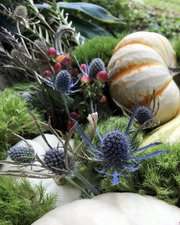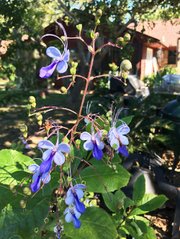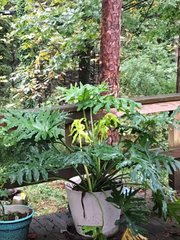Q I just brought my outside plants inside for the winter and wondered how often I should water them and should I fertilize them while they're inside?
A Houseplants often don't thrive inside in the winter, they merely survive. Our heated houses lack humidity; light levels are usually lower; and we usually have a static temperature. Water as little as possible to keep your plants living. Overwatering is the leading cause of houseplant problems. Water needs will vary based on temperature, light and pot size, but plants definitely need much less water inside than they do outside. Do not fertilize during the winter. Many plants slow their growth in the shorter, cooler days of fall and winter, so we don't want to add fertilizer. Don't be alarmed if you get some yellowing leaves as they acclimate to indoor conditions.
Q My husband wants to cut back my hydrangea because it is blocking the sprinkler and growing over a walkway. It's the type of hydrangea that doesn't bloom after pruning. Does it matter when I cut it back?
A I think your best bet would be to move the hydrangea to an area where it won't interfere with the sidewalk or sprinkler head and can grow to its full potential. While fall is not an ideal time to move hydrangeas, I would get it done as soon as possible and mulch it. Big leaf hydrangeas (Hydrangea macrophylla), which are the big blue- or pink-flowering hydrangeas, have their flower buds set now. Pruning it back, or winter damage that causes it to die back, will remove the flowers. There are some newer varieties that bloom on new canes as well as older canes, so you might consider planting one of those.
Q What is this blue flower? [The reader sent a photo.] It came in a flower arrangement, and we would like to identify it.
A The flower in question is commonly called sea holly, Eryngium planum. It is a perennial plant in Arkansas and has beautiful, deep blue, thistle-like blooms. It dries well and is often used in flower arrangements, because it is pretty for a long time in a vase.
Q Can you tell me what this plant is? [The reader sent a photo.] It's in a pot but it came up as a volunteer.
A Wow, I wonder where this plant came from. It is commonly called a blue butterfly bush, Clerodendrum ugandensee. It is a tropical plant and grows best in a frost-free climate. It is possible that it would come back from the roots in southern Arkansas, but it would die back to the ground after a frost.
Q What kind of plant is this and should I cut it back before putting it inside for the winter? [The reader sent a photo.] This is only the second summer it has been outside. Last winter I did not cut it back but instead I replanted it in a bigger pot. It is approximately 14 years old.
A The plant is a philodendron, commonly called tree philodendron -- Philodendron selloum. Moving tropical houseplants outside gets them growing in leaps and bounds because they thrive in heat and humidity, which we have in abundance every summer. They can become quite large and finding a place for them inside can become challenging with age. Do as little pruning as possible when you move it back inside, since you may have a little die-back as it adapts. Also, upgrading the pot size encourages even more growth. If you want to limit growth in future years, you can repot to prevent the pot-bound conditions, but while doing so shave off some roots along the side of the root ball and put it back into the same size container.
Janet B. Carson is a horticulture specialist for the University of Arkansas Cooperative Extension Service. Write to her at 2301 S. University Ave., Little Rock, Ark. 72204 or email her at
jcarson@arkansasonline.com
HomeStyle on 11/03/2018



